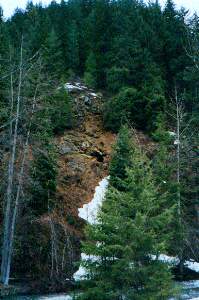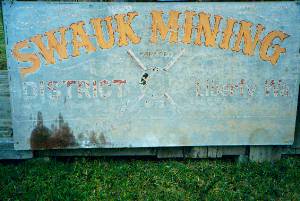
![]()

Along U.S. 2 about 23 miles north of the turn off to Liberty is this historical roadside marker where the townsite of Old Blewett once stood
Miners returning from the Fraser River strike in British Columbia discovered the first Swauk placer gold in 1858. By the 1860s Blewett was home to 200 miners and prospectors.


Mining tunnels from the bonanza years near Old Liberty. Some of the high-grade ore coming from the mines was astonishing, in certain instances it ran upwards of 500 ounces per ton. At today's prices that would be about $148,350.00 per ton.
It had the reputation as one of the most disorderly and violent mining camps in Chelan County. It was called "The Camp" in the early years and it was a hell-raising camp from the beginning.
When the quartz veins proved to carry great amounts of "free gold" in the quartz, the gulch was stampeded by miners and prospectors as word of the bonanza ore spread throughout the county. In 1879, a wagon road was built to connect the camp to the outside regions. By 1878 a stamp mill had been built to process the ore.

Swauk gold mining district was orgranized in 1873.
By the 1890s mining companies like the Blewett Company, were employing more and more miners and the camp began to expand. There was a busy hotel, general store, twenty stamp mill, livery stable, two saloons, post office, and several shacks, and cabins for miners.
But after those bonanza high-grade veins gave up producing the ore, so did Old Blewett.
Most signs of this once historic boom town has yielded to time, fire, and highway construction, but the stone foundation of the old stamp mill still remains. Old glory holes still honeycomb the mountains throughout this area. Many of these old mines can still be seen today from US 97 that winds through this rugged country.
![]()
